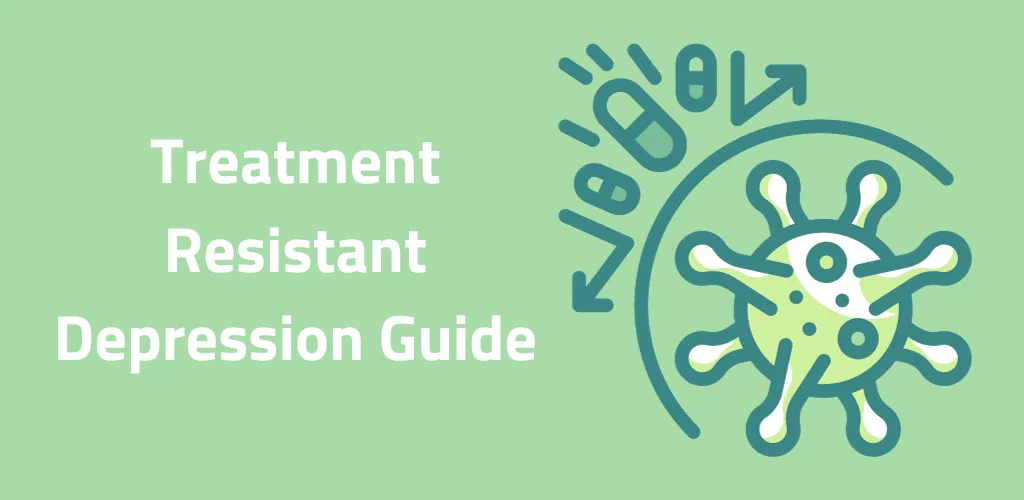When low mood, loss of interest, poor energy, and sleep/appetite changes persist despite trying medications, it’s fair to ask: Is this treatment-resistant depression (TRD)? Below is a psychiatry medication-first roadmap we use across our California offices to stage depression, define adequate trials, decide switch vs augmentation, and clarify when TMS or intranasal esketamine enters the picture. No therapy content here—just the pharmacologic and interventional algorithm you can expect at Advanced Psychiatry Associates (APA).
Defining TRD with Medical and Psychiatric Precision
Clinically, TRD is usually defined as an inadequate response to at least two antidepressants from different classes, each at a therapeutic dose and duration, with good adherence. We also stage depression severity/course (single vs recurrent episode), medical contributors (thyroid issues, sleep disorders, substances), and co-occurring psychiatric conditions that alter medication choice.
Where we start: a comprehensive medical/psychiatric evaluation, medication history (names, max doses, durations, tolerability), and objective baselines (e.g., PHQ-9, sleep, function) so progress is visible.
Learn more: Depression • Medication Management • Schedule an appointment
The Pharmacological Rule: Criteria for an Adequate Antidepressant Trial
A trial is adequate when all three are met:
Dose: typically at least the minimum therapeutic dose; many adults require moderate–high dosing if tolerated.
Duration: 4–6 weeks at target dose (not just titration weeks).
Adherence/Tolerability: taken as prescribed; side effects assessed and managed (timing, with food, slow titration, or switch).
If any of these are missing, we optimize the current agent before labeling the trial a failure.
The Sequencing Strategy: Switch, Augment, or Pivot?
Step A — First-line SSRI
Select an SSRI, titrate to a therapeutic range, and reassess at 4–6 weeks. If intolerable → switch. If partial response → consider dose optimization or move to Step B.
Step B — Switch to an alternative SSRI or to an SNRI
Alternate SSRI if some benefit/tolerability, but not enough.
SNRI (e.g., venlafaxine, desvenlafaxine, duloxetine) if pain syndromes, melancholic features, or prior SSRI non-response.
Switching makes sense when the first agent has no meaningful benefit or poor tolerability.
Step C — Augmentation when there’s a partial response
If you’ve improved but not remitted, we add a second agent rather than replace the base antidepressant. Common evidence-based choices:
Bupropion augmentation (can improve energy/attention; watch BP, anxiety activation).
Mirtazapine augmentation (sleep/appetite benefits; watch weight, lipids).
Lithium augmentation (suicide-risk benefits; requires serum levels, renal and thyroid monitoring).
Atypical antipsychotics at antidepressant-augmentation doses, e.g., aripiprazole, brexpiprazole, quetiapine XR (monitor metabolic profile, EPS/akathisia, sedation).
We select based on symptom profile (insomnia, low energy, appetite/weight), side-effect risks, comorbidities, and prior response patterns.
If two adequate antidepressant trials (with at least one augmentation or a class switch) fail to achieve remission or a durable response, we formally classify it as TRD and discuss interventional options.
Interventional Psychiatry Step 1: Transcranial Magnetic Stimulation (TMS)
Transcranial Magnetic Stimulation (TMS) uses focused magnetic pulses to stimulate mood-related brain circuits. It’s FDA-cleared for adults with major depressive disorder who haven’t improved with medications. No anesthesia; you can drive yourself afterward. A typical acute course is 5 sessions/week for ~6 weeks, with a brief taper/maintenance as appropriate.
Good candidates: inadequate response/intolerance to meds, preference to avoid systemic side effects, medical profiles that favor a non-drug option.
What to expect: mapping session (motor threshold), daily treatments, weekly symptom/functional tracking, mid-course adjustments.
Learn more or book at Transcranial Magnetic Stimulation (TMS) • Schedule an Appointment
Interventional Psychiatry Step 2: Intranasal Esketamine SPRAVATO
Intranasal Esketamine Treatment is FDA-approved for adults with treatment-resistant depression, when used together with an oral antidepressant, and for depressive symptoms in major depressive disorder (MDD) with acute suicidal ideation or behavior. At APA clinics, intranasal esketamine is delivered in clinic under a REMS program with vital-sign monitoring and observation for a few hours after each session, and patients are advised not to drive for the rest of the day, in line with evidence-based depression treatment guidelines.
Typical schedule: twice weekly for 4 weeks, then weekly to every other week for maintenance, personalized to response.
Expected effects: transient dissociation, dizziness, nausea, or short-term BP elevations—managed in-clinic.
Who benefits: patients with multiple adequate trials who require a different mechanism and structured monitoring.
Explore: Esketamine Treatment • Schedule an Appointment
The Safety Blueprint: Structured Vitals and Laboratory Monitoring
Before and during medication or interventional care, we monitor:
Vitals (BP/HR), weight, sleep; side effects (activation, GI, sexual, sedation).
Drug–drug interactions (including OTC/supplements).
Labs when indicated: lithium levels, TSH/creatinine (lithium), lipids/glucose (SGAs), LFTs as appropriate.
Pregnancy plans, cardiac history, and substance-use risks.
Objective outcomes: symptom scores plus real-life metrics (work/school attendance, morning start times, activity levels).
For TMS: treatment-day comfort/tolerability, parameter adjustments, weekly scales.
For Esketamine: REMS requirements, pre-/post-dose vitals, observation, and maintenance cadence.
Defining Success: Remission, Durability, and Functional Outcomes
Many patients respond after switching within SSRI/SNRI classes when trials are truly adequate.
Augmentation often converts partial response to remission—especially when the add-on is matched to the symptom profile.
TMS and esketamine provide non-oral mechanisms with track records of benefit in TRD, particularly when standard sequencing hasn’t delivered remission or tolerability.
Advanced Psychiatry Associates' goal is simple: remission (not just “better”), with durable function. We’ll sequence steps quickly—but safely—until we get there.
Ready to move beyond trial-and-error?
If you’re done waiting, book a fast medical consult at Advanced Psychiatry Associates to stage your depression correctly and follow a clear, evidence-based sequence, from SSRIs/SNRIs to augmentation, and, when appropriate, TMS or esketamine with structured monitoring.
Book now
Find APA California offices
You don’t need more willpower—you need a precise algorithm and a team that executes it.






